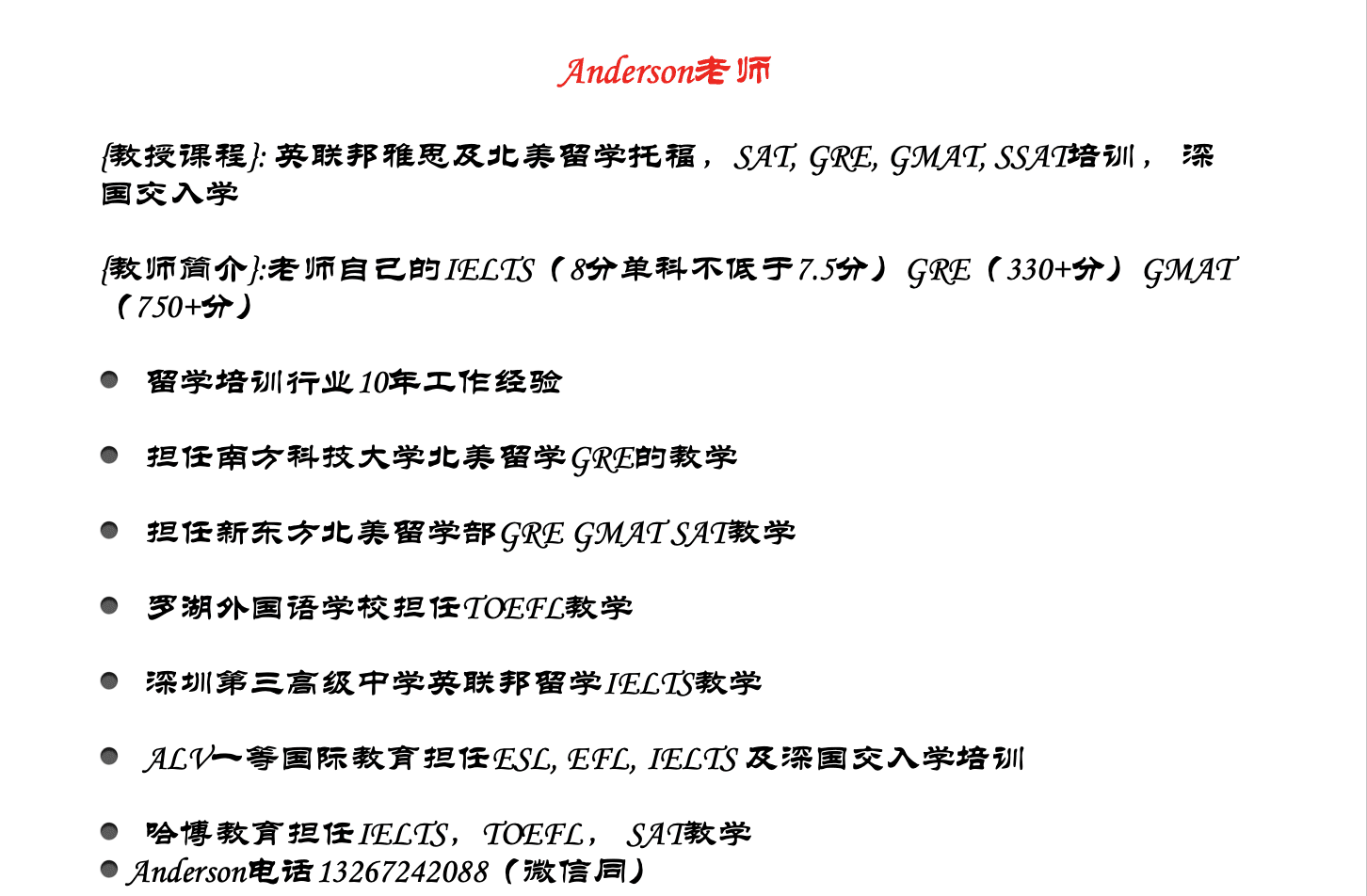- 开课日期:
随到随学/常年招生
- 上课时间:
自由安排
- 授课学校:
深圳安迪国际留学培训中心
- 授课地点:
福田中心区车公庙详细地图
- 咨询电话:
13267242088
课程介绍
Anderson老师
{教授课程}: 英联邦雅思及北美留学托福,SAT, GRE, GMAT, SSAT培训,
{教师简介}:老师自己IELTS(8分,单科不低于7.5分)GRE(330+分)GMAT(750+分)
* 留学培训行业10年工作经验
* 担任南方科技大学GRE的教学
* 担任新东方北美留学部GRE GMAT SAT及托福的班级课教学
* 罗湖外国语学校担任TOEFL教学
* 深圳第三高级中学英联邦留学IELTS教学
* ALV一等国际教育担任ESL, EFL, IELTS 及深国交入学培训
* 哈博教育担任IELTS,TOEFL, SAT/SSAT教学
* 等等等留学培训机构
现招生去英联邦留学的雅思考生,和北美留学的托福,SAT, GRE, GMAT, SSAT的考生培训,就老师自己带过的学生当中像语言类考试雅思或者托福或者SSAT的高分考生的真实案例非常多,而难度比较大的思维类考试SAT,GRE,GMAT考试当中,真实案例有SAT1500+, GRE325+,GMAT700+的考生。
不管是老师自己考到的留学类考试高分,还是老师自己丰富的留学培训的经历都不重要,重要的是课费实惠
课费实惠,课费实惠,重要的事情说三遍
Anderson:132-6724-2088(微信同)
正式安排课程之前免费试听demo,满意后再根据需要安排一个正式的课表
上课中心地址1(南山分店):深圳市南山区世界之窗美加广场A座(威尼斯睿图酒店对面,渣打银行楼上
自驾车请停美加广场停车场(欢乐谷正门对面,7-11旁)
地铁乘车路线:世界之窗站A出口,直行50米,然后往欢乐谷方向步行100米左右;
上课中心地址2(百花分店):深圳市福田区百花红荔路群星广场A座 (苏宁电器楼上;圣廷苑酒店对面)
乘车路线:华新地铁B出口
median or mode in the test. Without the qualifification of “arithmetic mean,” average can refer to a rate or the ratio of one quantity to another, as in “average number of miles per hour” or “average weight per truckload.” ! When mean is used in the context of data, it means arithmetic mean. ! The median of an odd number of data is the middle number when the data are listed in increasing order; the median of an even number of data is the arithmetic mean of the two middle numbers when the data are listed in increasing order. ! For a list of data, the mode of the data is the most frequently occurring number in the list. Thus, there may be more than one mode for a list of data. ! For data listed in increasing order, the fifirst quartile, second quartile, and third quartile of the data are three numbers that divide the data into four groups that are roughly equal in size. The fifirst group of numbers is from the least number up to the fifirst quartile. The second group is from the fifirst quartile up to the second quartile, which is also the median of the data. The third group is from the second quartile up to the third quartile, and the fourth group is from the third quartile up to the greatest number. Note that the four groups themselves are sometimes referred to as quartiles—fifirst quartile, second quartile, third quartile, and fourth quartile. The latter usage is clarifified by the word “in” as in the phrase “the cow’s weight is in the third quartile of the weights of the herd.” ! For data listed in increasing order, the percentiles of the data are 99 numbers that divide the data into 100 groups that are roughly equal in size. The 25th percentile equals the fifirst quartile; the 50th percentile equals the second quartile, or median; and the 75th percentile equals the third quartile. ! For a list of data, where the arithmetic mean is denoted by m, the standard deviation of the data refers to the nonnegative square root of the mean of the squared differences between m and each of the data. This statistic is also known as the population standard deviation and is not to be confused with the sample standard deviation. ! For a list of data, the range of the data is the greatest number in the list minus the least number. The interquartile range of the data is the third quartile minus the fifirst quartile.
显示全部
学校介绍
深圳安迪国际留学培训中心
学校人气度:2420
- 站内注册:
2012-01-01
- 课程总数:
共409个
- 主营业务:
留学培训
- 咨询老师:
申老师
深圳PTE学术英语雅思托福GRE和GMAT和SAT和SSAT一对一家教实惠培训
Anderson老师
{教授课程}: 英联邦雅思及北美留学托福,SAT, GRE, GMAT, SSAT培训, 深国交入学
{教师简介}:老师自己的IELTS(8分单科不低于7.5分)GRE(330+分)GMAT(750+分)
留学培训行业10年工作经验
担任南方科技大学北美留学GRE的教学
担任新东方北美留学部GRE GMAT SAT班级课教学
罗湖外国语学校担任TOEFL教学
深圳第三高级中学英联邦留学IELTS教学
ALV一等国际教育担任ESL, EFL, IELTS ,SSAT及深国交入学培训
哈博教育担任IELTS,TOEFL, SAT及SSAT教学
深圳非常早一批从事PTE学术英语培训的教师,
现招生英联邦及北美考试的考生,10年的留学培训经验Anderson积累了大量的教学经验及实战技巧,而且课费实惠
线上留学课程或者线下留学课程都可以安排,
相关课程
- 深圳雅思托福英语一对一短期出分家教中心好老师哪儿找 面议已有23人浏览开课日期:随到随学
- 深圳KET/PET英语一对一短期出分家教中心好老师哪儿找 面议已有19人浏览开课日期:随到随学
- 深圳GMAT英语一对一短期出分家教中心好老师哪儿找 面议已有14人浏览开课日期:随到随学
- 深圳GRE英语一对一短期出分家教中心好老师哪儿找 面议已有24人浏览开课日期:随到随学
- 深圳PTE学术英语一对一短期出分家教中心好老师哪儿找 面议已有17人浏览开课日期:随到随学
- 深圳ISEE一对一短期出分家教中心好老师哪儿找 面议已有26人浏览开课日期:随到随学
加载更多
热门推荐



